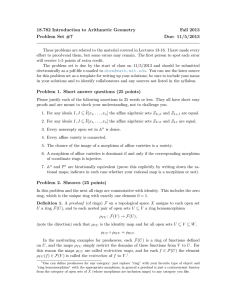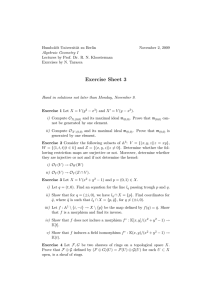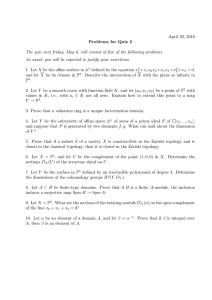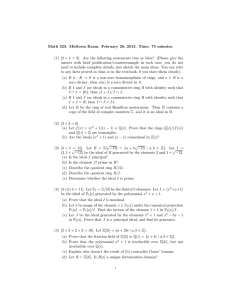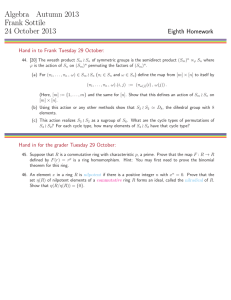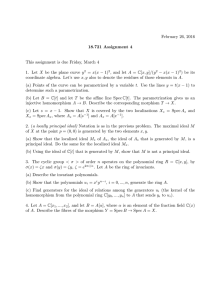18.782 Introduction to Arithmetic Geometry Fall 2013 Problem Set #7 Due: 11/5/2013
advertisement
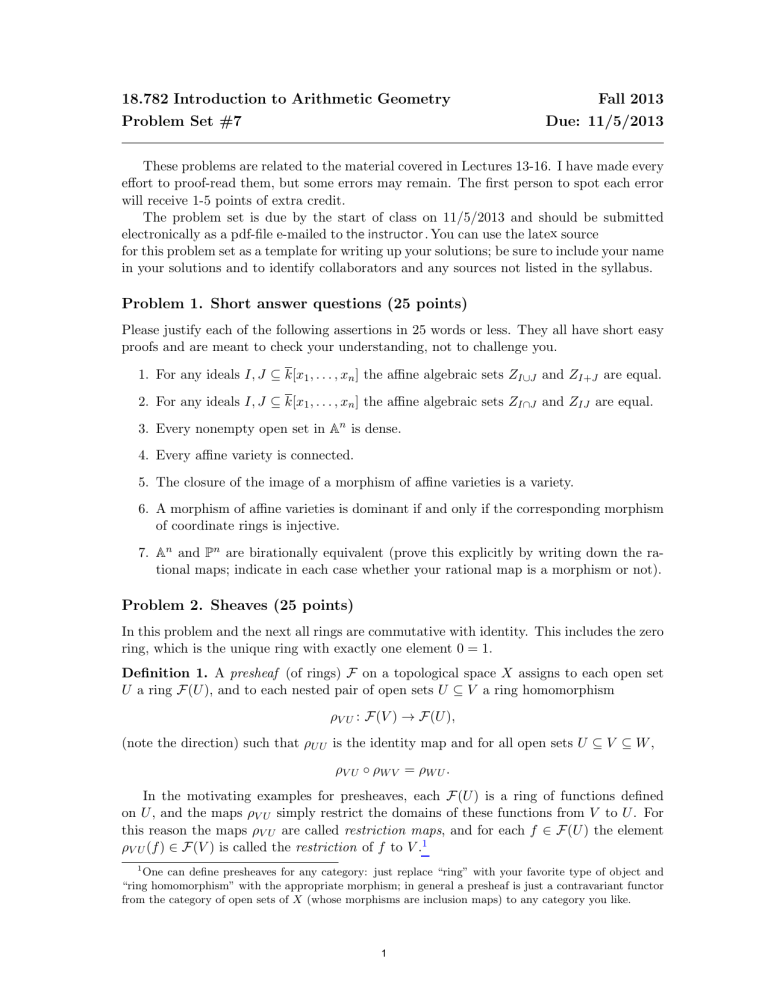
18.782 Introduction to Arithmetic Geometry
Problem Set #7
Fall 2013
Due: 11/5/2013
These problems are related to the material covered in Lectures 13-16. I have made every
effort to proof-read them, but some errors may remain. The first person to spot each error
will receive 1-5 points of extra credit.
The problem set is due by the start of class on 11/5/2013 and should be submitted
electronically as a pdf-file e-mailed to the instructor . You can use the latex source
for this problem set as a template for writing up your solutions; be sure to include your name
in your solutions and to identify collaborators and any sources not listed in the syllabus.
Problem 1. Short answer questions (25 points)
Please justify each of the following assertions in 25 words or less. They all have short easy
proofs and are meant to check your understanding, not to challenge you.
1. For any ideals I, J ⊆ k[x1 , . . . , xn ] the affine algebraic sets ZI∪J and ZI+J are equal.
2. For any ideals I, J ⊆ k[x1 , . . . , xn ] the affine algebraic sets ZI ∩J and ZIJ are equal.
3. Every nonempty open set in An is dense.
4. Every affine variety is connected.
5. The closure of the image of a morphism of affine varieties is a variety.
6. A morphism of affine varieties is dominant if and only if the corresponding morphism
of coordinate rings is injective.
7. An and Pn are birationally equivalent (prove this explicitly by writing down the rational maps; indicate in each case whether your rational map is a morphism or not).
Problem 2. Sheaves (25 points)
In this problem and the next all rings are commutative with identity. This includes the zero
ring, which is the unique ring with exactly one element 0 = 1.
Definition 1. A presheaf (of rings) F on a topological space X assigns to each open set
U a ring F(U ), and to each nested pair of open sets U ⊆ V a ring homomorphism
ρV U : F(V ) → F(U ),
(note the direction) such that ρU U is the identity map and for all open sets U ⊆ V ⊆ W ,
ρV U ◦ ρ W V = ρW U .
In the motivating examples for presheaves, each F(U ) is a ring of functions defined
on U , and the maps ρV U simply restrict the domains of these functions from V to U . For
this reason the maps ρV U are called restriction maps, and for each f ∈ F(U ) the element
ρV U (f ) ∈ F(V ) is called the restriction of f to V .1
1
One can define presheaves for any category: just replace “ring” with your favorite type of object and
“ring homomorphism” with the appropriate morphism; in general a presheaf is just a contravariant functor
from the category of open sets of X (whose morphisms are inclusion maps) to any category you like.
1
Now let X be an affine variety over k = k with function field k(X).
(a) Show that for any open set U ⊆ X the set
O(U ) = {f ∈ k(X) : U ⊆ dom(f )}
is a subring of k(X) that contains k (hence is a k-algebra), and has fraction field k(X).
Prove that O(X) is equal to the coordinate ring k[X].
(b) For open sets U in X, let F(U ) = O(U ), and for nested open sets U ⊆ V in X, let
ρV U be the inclusion map O(V ) ⊆ O(U ). Show that F is a presheaf.
Definition 2. An open cover of an open set U is a collection of open sets {Uα }α∈A whose
union is U . A presheaf F is a sheaf if it satisfies the sheaf axiom.
S
Sheaf axiom: For every open cover {Ua }a∈A of U = a Ua and every collection {fa } with
fa ∈ F(Uα ) such that for all a, b ∈ A the restrictions of fa and fb to Ua ∩ Ub are equal, there
is a unique f ∈ F(U ) whose restriction to Ua is fa for all a ∈ A.
(c) Prove that in any sheaf of rings F, the ring F(∅) must be the zero ring.2
(d) Modify the presheaf F defined in part (b) so that F(∅) is the zero ring and ρU ∅
is the unique homomorphism to the zero ring (for each open set U ). The resulting
presheaf OX is called the structure sheaf of X. Prove that OX is indeed a sheaf.3
Definition 3. A pair (X, OX ) where X is a topological space and OX is a sheaf of rings
on X is called a ringed space.
Problem 3. Affine schemes (50 points)
As in Problem 2, all rings in this problem are commutative rings with identity.
Let R be a ring whose elements f we shall call regular functions. Let
X = spec R
be the set of prime ideals of R. We shall call the elements P of X points. For any point
P ∈ X, the residue field of P is the quotient field of the integral domain R/P . For any
regular function f ∈ R and any point P ∈ X we define f (P ) to be the image of f in the
residue field of P (this means we reduce f mod P to get an element f¯ of R/P that we then
regard as the element f¯/1 of the fraction field). Notice that f (P ) is defined at every point
P ∈ X, which is why we call f a regular function. The field in which f (P ) lies will vary
with P , but in any case we can meaningfully ask whether f (P ) = 0 or not. We now define
an algebraic set Z as the zero locus of a set of regular functions S ⊆ R:
ZS = {P ∈ X : f (P ) = 0 for all f ∈ S}.
We now endow X with the Zariski topology by letting the closed sets be the algebraic sets.
2
Some authors include this restriction in the definition of a presheaf, but this is unnecessary.
While this modification may seem artificial, it can actually be justified by noting that if you restrict the
domain of a set of functions with the same codomain to the empty set they become a single function (there
is exactly one function from the empty set to a given set S, it is the function whose graph is the empty set).
3
2
(a) Prove that this actually defines a topology by showing that the empty set and X are
both closed, and that arbitrary intersections and finite unions are closed.
(b) Show that for S ⊆ R the algebraic set ZS is precisely the set of prime ideals of R
(points of X) that contain S, and that ZS = ZI , where I is the ideal generated by S.
(c) We call a point P ∈ X a closed point if the set {P } is closed in the Zariski topology.
Prove that the closed points in X are precisely the maximal ideals of R.
(d) Let R be the polynomial ring k[x1 , x2 ] for some field k = k. Give a bijection between
closed points P in X and elements (a1 , a2 ) of A2 (k), and show that under this bijection
we have f (P ) = f (a1 , a2 ) for any f ∈ R and closed point P . Describe the points of
X that are not closed and evaluate 3x21 + 2x1 x2 − 5x22 at two such points.
(e) Let R = Z. Describe the opens sets in X and the residue fields at points P ∈ X.
Evaluate 15 ∈ R at the points (0), (2), (3), (5) ∈ X, and describe the zero locus of 15.
Now let V ⊆ An be an affine variety of dimension 1 over a field k = k, let R = k[V ] be
its coordinate ring, let k(V ) be its function field, and let X = spec R.
(f ) Prove that every point in V corresponds to a maximal ideal of k[x1 , . . . , xn ] that
contains I(V ), which in turn corresponds to a maximal ideal of R, hence a closed
point in X. We may therefore identify V with the set of closed points in X.
(g) Prove that the only point in X that is not in V is the zero ideal and that this point
is dense in X and contained in every nonempty open set in X.
(h) Let us say that an element f = g/h of the function field k(V ) is regular at P ∈ X
6 0 (where h(P ) is defined as above). Argue that for points P ∈ V this
if h(P ) =
definition agrees with the corresponding definition given in Lecture 15. Then show
that every f ∈ k(V ) is regular at the point P = (0) and that we may thus add (0) to
dom(f ) for every f ∈ k(V ).
Definition 4. An affine scheme is a ringed space (X, OX ) where X = spec R for a ring R.
(i) Use (h) to define a structure sheaf OX for X = spec k[V ], as in part (d) of Problem 2,
thereby constructing an affine scheme corresponding to V .
(j) Use (e) to define a structure sheaf OX for X = spec Z.
Just in case you are interested, here is the general definition of a scheme.
Definition 5. A scheme is a ringed space (X, OX ) for which every point has a neighborhood U for which (U, OU ) is an affine scheme, where OU is OX restricted to U .
Problem 4. Survey
Complete the following survey by rating each problem on a scale of 1 to 10 according to how
interesting you found the problem (1 = “mind-numbing,” 10 = “mind-blowing”), and how
difficult you found the problem (1 = “trivial,” 10 = “brutal”). Also estimate the amount
of time you spent on each problem.
3
Interest
Difficulty
Time Spent
Problem 1
Problem 2
Problem 3
Please rate each of the following lectures that you attended, according to the quality of the
material (1=“useless”, 10=“fascinating”), the quality of the presentation (1=“epic fail”,
10=“perfection”), the pace (1=“way too slow”, 10=“way too fast”), and the novelty of the
material (1=“old hat”, 10=“all new”).
Date
10/24
10/29
Lecture Topic
Morphisms and rational maps
Function fields
Material
Presentation
Pace
Novelty
Feel free to record any additional comments you have on the problem sets or lectures; in
particular, how you think they might be improved.
4
MIT OpenCourseWare
http://ocw.mit.edu
,QWURGXFWLRQWR$ULWKPHWLF*HRPHWU\
)DOO 201
For information about citing these materials or our Terms of Use, visit: http://ocw.mit.edu/terms.
